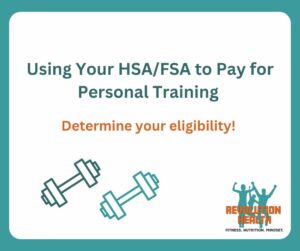Maximizing Your Health Investment
Welcome to a new era of healthcare investment! Did you know that your FSA (Flexible Spending Account) or HSA (Health Savings Account) card could be your ticket to achieving your fitness goals? In this post, we’ll explore the ins and outs of using your FSA and HSA accounts to cover the costs of personal training sessions. Say goodbye to the misconception that these cards are solely for medical expenses. Let’s use them to their full potential! While you cannot use these accounts to pay for personal training for general health and well-being, you may be eligible for the treatment of a medical condition with a Letter of Medical Necessity. Keep reading for details but here is a brief list of the steps you will want to take:
Step 1. Determine if your prospective trainer accepts HSA/FSA as payment. Not all of them do!
Step 2. Understand eligible expenses for your account.
Step 3. Talk to your doctor about a Letter of Medical Necessity.
Step 4: Call your account administrator to confirm eligibility.
Understanding FSA and HSA Cards
Flexible Spending Accounts (FSA) and Health Savings Accounts (HSA) are financial tools designed to help individuals save for medical expenses while offering tax advantages. A brief overview of each is below.
Flexible Spending Account (FSA):
An FSA is an employer-sponsored benefit that allows employees to set aside pre-tax dollars from their paychecks to cover qualified medical expenses.
These funds can be used for a wide range of healthcare expenses, including doctor visits, prescription medications, and certain medical supplies.
FSA funds are typically “use it or lose it.” This means that any unused funds at the end of the plan year may be forfeited. Sometimes, employers offer a grace period or carryover option.
Health Savings Account (HSA):
An HSA is a tax-advantaged savings account available to individuals enrolled in a high-deductible health plan (HDHP).
Contributions to an HSA are made on a pre-tax basis, reducing taxable income. They can be used to pay for qualified medical expenses, including deductibles, copayments, and certain medical services.
Unlike FSAs, HSA funds roll over from year to year. Additionally, the can be invested for potential growth, making them a valuable long-term savings tool for healthcare expenses in retirement.
Eligible Expenses
Both FSA and HSA funds can be used to cover a wide range of qualified medical expenses, as defined by the Internal Revenue Service (IRS). These expenses may include medical, dental, and vision care, as well as certain over-the-counter medications and supplies.
Personal training sessions are NOT typically considered eligible medical expenses. However, there are exceptions when fitness programs are prescribed by a healthcare provider to treat a specific medical condition. They may also be part of a weight-loss program to alleviate obesity-related health issues. Examples of qualifying conditions could include back pain, arthritis, diabetes, hypertension, fibromyalgia, chronic fatigue, and obesity. Furthermore, you may be eligible for mental health conditions such as high stress, anxiety, and depression. Read on to learn more about determining your eligibility and the next steps for paying for a personal trainer using your FSA or HAS account.
Letter of Medical Necessity
If you think you have a medical condition that would benefit from a personal training program, talk with your doctor about whether it may qualify. Explain that you have an FSA or HSA and that you would like to use your pretax funds toward your fitness program. If you qualify, you will need to get a Letter of Medical Necessity (LMN) from your doctor. This letter must outline how your medical condition necessitates a personal trainer, how the treatment will be used to alleviate the issue, and how long the treatment will last. If the treatment plan exceeds the current plan year, another LMN will have to be provided to the benefits administrator to cover the duration of the treatment.
The Letter of Medical Necessity should include all of the following information:
Patient identification
This includes the patient’s name, date of birth, the policyholder’s name, policy number, and group number.
Date of most recent physical
The date the patient was last examined by the treating physician.
Patient’s history and diagnosis
Information on the patient’s specific physical or mental condition or illness. Also, include any information about the patient’s history that is relevant to their condition.
Recommended treatment
This should also be described in detail and list any equipment, medication, and therapies required.
Treatment duration
This is the length of treatment required. It should not exceed 12 months.
Summary
This is a brief recap of the physician’s recommendation.
Signature
This includes the treating physician’s signature, license number, contact information, and date of issue.
Supporting records
Attach any supporting documents, such as labs, test results, and progress notes.
Once you are issued a Letter of Medical Necessity, you will want 3 copies: one copy should go on your medical record, another copy sent to your FSA or HSA administrator, and one copy for your files. Next, contact your account administrator to confirm the recommended treatment (personal training) is eligible for reimbursement.
Final Words
In summary, understanding the differences between FSAs and HSAs, as well as their respective rules and regulations, is essential for making informed decisions about using these accounts to cover healthcare expenses. This may include personal training sessions. While there are limitations on what expenses may be eligible for reimbursement, exploring creative solutions and consulting with a qualified healthcare provider can help maximize the benefits of these accounts for your health and well-being. If you are considering hiring a personal trainer and plan to use your FSA or HSA, utilize the steps outlined above to help make sure the process goes smoothly.



